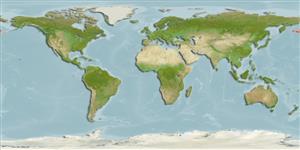分類 / Names
俗名 | 同種異名 | Catalog of Fishes(屬, 種) | ITIS | CoL | WoRMS | Cloffa
Teleostei >
Perciformes/Cottoidei (Sculpins)
鮋形目 (Sculpins) >
Liparidae (Snailfishes)
獅子魚科 (Snailfishes)
Etymology: Careproctus: Greek, kara = face + Greek, proktos = anus (Ref. 45335); zachirus: Named for the long pectoral fin..
Environment: milieu / climate zone / depth range / distribution range
生態學
海洋 深海底的; 深度上下限 150 - 850 m (Ref. 51661), usually 400 - 500 m (Ref. 56456). 深水域
Northwest Pacific: Amchatka Pass, Alaska.
西北太平洋: Amchatka 通過, 阿拉斯加州。
大小 / 重量 / 年齡
Maturity: Lm ? range ? - ? cm
Max length : 32.0 cm TL 雄魚/尚未辨別雌雄; (Ref. 56456); common length : 22.0 cm TL 雄魚/尚未辨別雌雄; (Ref. 56456); 最大體重: 500.00 g (Ref. 56456); 最大年齡: 7 年 (Ref. 56456)
簡短描述
檢索表 | 型態特徵 | 形態測量圖
背棘 (總數) : 0; 背的軟條 (總數) : 51 - 53; 臀棘: 0; 臀鰭軟條: 43 - 45; 脊椎骨: 56 - 58. Pectoral fin distinctly notched; caudal fin broad, continuous with dorsal and anal fins for about two-thirds of its length, end of dorsal fin forming notch on caudal fin (Ref. 12700). Body pinkish; eye black; posterior part of upper pectoral fin lobe stained with black in both outer and inner sides; black bands of dorsal and anal fins jointed each other in the middle of the caudal fin (Ref. 12700).
胸鰭明顯地凹槽; 尾鰭寬的, 對於大約它的長度中的三分之二與背鰭與臀鰭續接在一起, 在尾鰭上的背鰭末端形成凹槽.(參考文獻 12700) 身體略帶桃色的; 眼黑色; 染有黑色的上面胸鰭葉的較後面的部分在外部而內部的側邊中; 背鰭與臀鰭的黑色條紋在尾鰭的中央中的有接縫的彼此.(參考文獻 12700)
Life cycle and mating behavior
Maturities | 繁殖 | Spawnings | Egg(s) | Fecundities | 仔魚
西北太平洋: Amchatka 通過, 阿拉斯加州。
Kido, K., 1985. New and rare species of the genus Careproctus (Liparididae) from the Bering Sea. Jap. J. Ichthyol. 32(1):6-17. (Ref. 12700)
人類使用
漁業: 沒有興趣
工具
特別的報告
下載 XML
網路資源
Estimates based on models
Preferred temperature (Ref.
123201): 3.2 - 3.6, mean 3.5 °C (based on 7 cells).
Phylogenetic diversity index (Ref.
82804): PD
50 = 0.5000 [Uniqueness, from 0.5 = low to 2.0 = high].
Bayesian length-weight: a=0.00692 (0.00380 - 0.01261), b=3.14 (2.98 - 3.30), in cm total length, based on LWR estimates for this species & Genus-body shape (Ref.
93245).
營養階層 (Ref.
69278): 3.4 ±0.47 se; based on food items.
回復力 (Ref.
120179): 中等的, 族群倍增時間最少 1.4 - 4.4年 (Preliminary K or Fecundity.).
Fishing Vulnerability (Ref.
59153): Low vulnerability (22 of 100).
